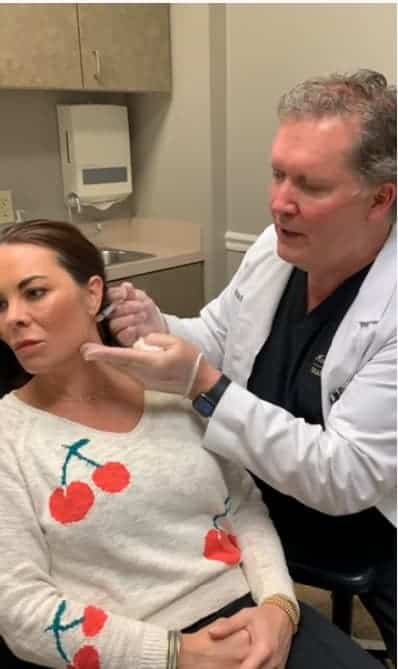Our jawbone plays a very important role in our appearance. It is truly the foundation of the face. When we think about beauty, it is all about proportion and balance. The face is divided into thirds. The upper third is from the hairline to in between the eyebrows. The second third is from the eyebrows to the bottom of the nose. The third portion is from the bottom of the nose down to the jaw.
An interesting fact about our jaw is that it is the bone in our body that changes the most throughout our lives. As we age, the jawbone begins to decrease in height. Subsequently, we lose the back of the jaw. This contributes to the skin/facial tissues falling toward the mouth, creating the jowls. As a cosmetic surgeon, my goal for this concern is to recreate some of the structure of the jaw, especially toward the back of the jaw. By reinforcing the structure of the jaw, it will help to lift those facial tissues up.
A liquid lift procedure can be used to strengthen the jawline. Even in patients who opt for surgery, I usually build up the back of the jaw with some of their supporting facial tissues or fat. In the office, we are lucky to have two options available. The first option is using the hyaluronic acid (HA) fillers that most patients are familiar with. These include the Juvederm products such as Voluma, Vollure, Ultra Plus and Ultra XC. We certainly have used those in many other places of the face including underneath the eyes, the folds between the mouth and the cheek (nasolabial folds), the marionette lines and to plump lips. It is very common to place these products at the back of the jaw too.
If a patient has the pressure of an upcoming event, it is a nice way to build up the jawline very quickly. If they have the luxury of time, another option is to think about using Sculptra. Sculptra is not really a filler; it is polylactic acid. Polylactic Acid is a volumizing product. It is injected under the skin to reinforce the structure of the skin. The purpose of using the Sculptra treatment is to encourage the production of new collagen. Collagen helps provide the skin with structure and cushion. As I inject the Sculptra, I am targeting the stem cells in the body, which then change the collagen producing cells. It is most effective when used as a series of treatments, and it’s best to space out these treatments about one month apart. Each treatment consists of 2-3 bottles, making the total amount of product equal to 9mL. A syringe of HA filler is 1mL, so using Sculptra is a great benefit for the patient needing more volume. At the end of the Sculptra series, we can evaluate the results of the 3 treatments. Additionally, some patients like the idea of having their body create collagen and have the jaw rebuild itself. The Sculptra can last up to two years. The HA fillers, depending on which one we use, can last a year to 18 months. Each patient is different, and results may vary.
If a patient desires surgery, implant surgery for the back of the jaw is an option, but it can be a bit tricky. It is challenging to secure an implant to the back of the jaw, as there is a lot of movement in the back of the jawline; a custom jaw implant is a possibility. With that, we send the patient for a CAT scan. From the CAT scan results, we see the shape of the jaw; then we can create an implant to try and rebuild the jawline. The advantage of a surgical implant is that it offers the patient a long-term option. The disadvantage is that it requires a trip to the operating room and results may be less than fully desired. Dr. Brian Maloney, is Double Board Certified Plastic Surgeon, specializing in all facets of facial plastic surgery. If you have noticed a decrease in jawbone height or any question about turning back the clock on your face, book a consultation today.

